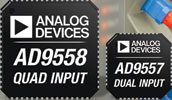Adaptive clock translators
23 November 2011
Telecoms, Datacoms, Wireless, IoT

Analog Devices has introduced two fully programmable jitter attenuating clock translators ICs that perform frequency translations for a wide range of wired communications applications – including Synchronous Ethernet and SONET/SDH optical networks – that require low jitter.
The AD9557 dual-input multiservice line card device and the AD9558 quad-input multiservice line card device translate any standard input frequency to any standard output frequency from 2 kHz to 1,25 GHz with sub 400 fs RMS total jitter on 12 kHz to 20 MHz. The new clock translators provide a high-performance alternative to traditional PLL (phase locked loop) designs that require the addition of expensive VCXOs (voltage-controlled crystal oscillators).
The built-in programmability of the AD9557 and AD9558 allow network line card designers to use the same component in many different board designs. This includes synchronisation for a wide variety of high-performance applications, including data communications, next-generation wired networking applications, telecommunications, test and measurement, high-speed data acquisition and wireless base station controllers.
Both devices integrate an on-chip, low-phase-noise, frequency-agile VCO (voltage-controlled oscillator) and loop filter along with dynamic adaptive clock support. Adaptive clocking allows the DPLL (digital PLL) divider ratios to be changed while the DPLL is locked. This enables the frequency value at the output to be dynamically adjusted by up to ±100 ppm from the nominal output frequency without manually breaking the loop and reprogramming the part with a sub 0,1 ppb step in frequency resolution. This adaptive clock function is used for applications such as SDH to OTN mapping/demapping and asynchronous mapping/demapping.
The adaptive clock translators’ programmable DPLL supports loop bandwidth from 0,1 Hz to 5 kHz and features three separate programming modes for ease of use and flexibility. The two devices are pin- or soft-pin pre-configured to support popular SONET/SDH, Ethernet, Synchronous Ethernet and Fiber Channel frequencies, while SPI and I²C ports are available to program customised input-to-output frequency translation.
At 6 x 6 mm and 9 x 9 mm in size, respectively, the AD9557 and AD9558 provide compact, cost effective clocks for line card designers. The AD9557 features two reference inputs (single-ended or differential) and two pairs of clock outputs. Each output pair is configurable as a single differential LVDS/HSTL output or as two single-ended CMOS outputs. The AD9558 offers the same features but with four reference inputs and six pairs of clock outputs.
Further reading:
The trends driving uptake of IoT Platform as a Service
Trinity IoT
Editor's Choice Telecoms, Datacoms, Wireless, IoT
IoT platforms, delivered as a service, are the key that will enable enterprises to leverage a number of growing trends within the IT space, and access a range of benefits that will help them grow their businesses.
Read more...
RF power amplifier
RF Design
Telecoms, Datacoms, Wireless, IoT
The ZHL-20M2G7025X+ from Mini-Circuits is a 32 W power amplifier that operates from 20 to 2700 MHz and delivers a saturated output power of +45 dBm.
Read more...
Introducing the Quectel EG800Z series
iCorp Technologies
Telecoms, Datacoms, Wireless, IoT
The EG800Z series is Quectel’s latest ultra-compact LTE Cat 1 bis module, designed to deliver reliable connectivity, low power consumption, and robust performance across a wide range of IoT applications.
Read more...
NeoMesh on LoRa
CST Electronics
Telecoms, Datacoms, Wireless, IoT
Thomas Steen Halkier, CEO of NeoCortec, recently gave a keynote speech where he spoke about “NeoMesh on LoRa: Bringing true mesh networking to the LoRa PHY”.
Read more...
Modules upgraded with Direct-to-Cell tech
iCorp Technologies
Telecoms, Datacoms, Wireless, IoT
Quectel Wireless Solutions has announced that several of its LTE modules are now available with Direct-to-Cell (D2C) functionality, enabling devices to seamlessly connect to satellite networks.
Read more...
USB/Ethernet smart RF power sensor
RF Design
Telecoms, Datacoms, Wireless, IoT
The PWR-18PWHS-RC from Mini-Circuits is an RF power sensor that operates from 50 MHz to 18 GHz and is designed to capture pulsed and trace modulated signals with very high data resolution.
Read more...
Tiny Bluetooth LE + 802.15 + NFC module
RF Design
Telecoms, Datacoms, Wireless, IoT
Unleashing enhanced processing power, expanded memory, and innovative peripherals, the BL54L15µ from Ezurio is the ultimate choice for small and low power connectivity.
Read more...
AI modules for edge intelligence
Otto Wireless Solutions
Telecoms, Datacoms, Wireless, IoT
SIMCom has introduced two new entry-level AI computing modules, the SIM8668 and SIM8666, designed to bring intelligent capabilities to lightweight, energy-efficient edge devices.
Read more...
High performance ISM antennas
iCorp Technologies
Telecoms, Datacoms, Wireless, IoT
Quectel Wireless Solutions has announced the launch of two new high performance ISM antennas, designed to meet the need for wireless communication in devices that operate in the industrial and commercial applications.
Read more...
Quad-band high-precision positioning module
iCorp Technologies
Telecoms, Datacoms, Wireless, IoT
Quectel Wireless Solutions has recently announced the launch of the LG680P, a multi-constellation, quad-band GNSS module designed to deliver high-precision positioning across a wide range of applications.
Read more...


